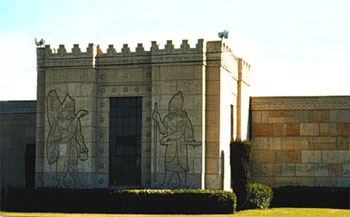The Samson Tire Company
In 1918 Adolph Schleicher started his Samson Tire and Rubber Company in a tiny wood-frame
factory in Compton, choosing "Samson" because it symbolized strength and endurance.
After Les Molineux returned from his service in WW1 he married and went to work
for the Samson Tire Company. In January 1928, Adolph Schleicher, owner of Samson
Tire and Rubber Company, embarked on development of a new factory in East Los Angeles
-- one that would become the largest manufacturing facility under one roof west
of the Mississippi. Schleicher wanted to include a Samson and Delilah motif. Thus
the plant was modeled after a 7th Century B.C. ancient Assyrian palace including
a 1,350-foot-long (later expanded to 1,750) crenulated concrete wall decorated with
heraldic griffins and bas-reliefs of Babylonian princes carved into the stone between
impressive pillars and towers. The design, dedicated to the civilizations of Sumeria,
Akkadia and Babylonia, conveys strength and style.

On January 23, 1929, ground broke for the $8 million Samson Tire and Rubber Company
plant, the largest tire manufacturing facility on the West Coast (attended by 12,000
people). At the behest of Schleicher, the original architects (Morgan, Walls and
Clements) designed the wall in the style of King Sargon II's palace. Sargon was
a Babylonian King with a 23-acre palace and Schleicher's plant, coincidentally or
by design, covered the same amount of land. The portion of the wall that fronts
the office building features genii, winged guardian figures protecting individuals
from evil. The plant entrance featured another form of genii -- winged bulls with
human heads -- also intended to guard the interior as those on Sargon's palace.
October 29, 1929. Stock market crashed.
In May, 1930, the Samson Tire and Rubber Company plant opens with no public ceremony
and with the capacity to produce 6,000 tires and 10,000 tubes a day. January, 1931,
US Tire and Rubber Company purchases and takes over the newly completed Samson Tire
Company. Les Molineux worked at the facility continuously until he retired.
In September, 1960. Adolph Schleicher, owner of Samson Tire and Rubber Company dies,
followed seven months later by Les Molineux's own death.
The US Tire and Rubber Company becomes Uniroyal Tire in 1962. The plant operated
for nearly half a century until Uniroyal closed the facility on March 3, 1978.
For the next several years the plant changed ownership as its future use was debated.
In July 1979, DAON Southwest Company purchases the property. Then in 1982 the California
State Historical Resources Commission approved the site nomination to the National
Register of Historic Places. October 1983 the City of Commerce purchases the property
for $14 million as part of an effort to prevent demolition of the landmark building.
In November 1989, Trammell Crow Company signs a long-term ground lease with the
City of Commerce Redevelopment Agency.
January 25, 1990, Trammell Crow Company breaks ground for a $118 million, 742,000
square foot mixed-use project including a factory outlet retail center, five office
buildings, a food court and a 201-room Double Tree Hotel. Gretchen Schleicher Davis
of Pasadena, California, the eldest daughter of Adolph Schleicher, wielded the same
silver shovel and pick that she used at the groundbreaking 61 years ago, nearly
to the day, when the original Samson Tire and Rubber Company broke ground. November
23, 1990, Citadel (strong fortress; city within a city) opens its doors with merchandise
priced 30% to 70% below retail. More than 19,000 shoppers pass through the mall.
Today you can drive to an Assyrian palace to buy blue jeans and leather goods. The
Citadel Outlets, Los Angeles' only outlet center, has the distinct honor to be located
behind an Assryian Castle wall.